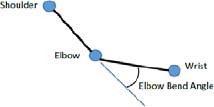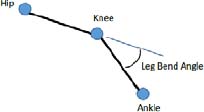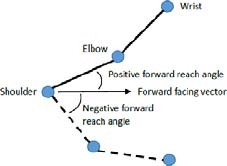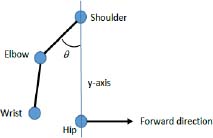| Elbow bend angle |
Elbow bend angle is an exterior angle between the upper arm vector (shoulder to elbow joint) and lower arm vector (elbow joint to wrist)
In a standing position, the elbow bend angle is zero with straight arms. When the elbow bend angle is above the threshold (22.5°), the elbow is regarded as bending |
 |
| Non-flat foot landing |
Foot angle is an angle between the foot vector (ankle joint to foot) and horizontal plane (ground)
In a standing position, the foot angle is zero with flat foot. When the foot angle is below the threshold (15°), the foot is regarded as flat landing |
 |
| Leg bend angle |
Similar to elbow bend angle, leg bend angle is an exterior angle between the upper leg vector (hip to knee joint) and lower leg vector (knee joint to ankle)
In a standing position, the leg bend angle is zero with straight legs. When the leg bend angle is above the threshold (72°), the leg is regarded as bending |
 |
| Arm forward reach angle |
Forward facing vector is defined by the cross product of hip vector (left hip to right hip) and upward spine vector
Arm forward reach angle is defined as the angle of the upper arm relative to the forward facing vector
The forward reach angle is positive when the upper arm vector is above the shoulder, negative when the upper arm vector is below the shoulder |
 |
| Leg swing angle |
Leg swing angle is the difference between the minimum and maximum value of the exterior angle between the upper leg vector and forward facing vector |
 |
| Arm forward/backward swing angle |
Arm forward/backward swing is defined as the angle between the upper arm vector and vertical y-axis with reference to the forward direction
When the upper arm vector is behind the vertical axis, it is an arm backward swing angle (negative), or vice versa |
 |